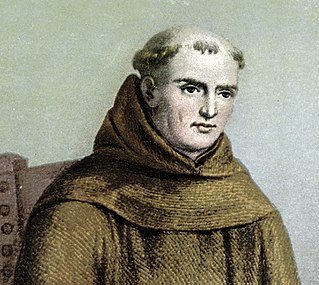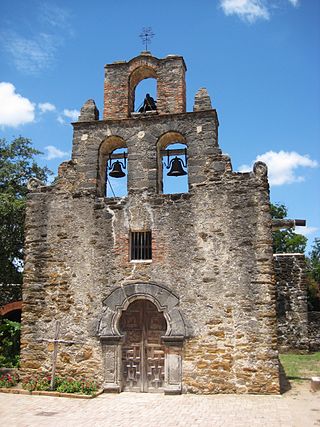
Jewellery consists of decorative items worn for personal adornment, such as brooches, rings, necklaces, earrings, pendants, bracelets, and cufflinks. Jewellery may be attached to the body or the clothes. From a western perspective, the term is restricted to durable ornaments, excluding flowers for example. For many centuries metal such as gold often combined with gemstones, has been the normal material for jewellery, but other materials such as glass, shells and other plant materials may be used.

The Spanish missions in California formed a series of 21 religious outposts or missions established between 1769 and 1833 in what is now the U.S. state of California. The missions were established by Catholic priests of the Franciscan order to evangelize indigenous peoples backed by the military force of the Spanish Empire. The missions were part of the expansion and settlement of New Spain through the formation of Alta California, expanding the empire into the most northern and western parts of Spanish North America. Civilian settlers and soldiers accompanied missionaries and formed settlements like the Pueblo de Los Ángeles.

Saint Junípero Serra Ferrer, popularly known simply as Junipero Serra, was a Spanish Catholic priest and missionary of the Franciscan Order. He is credited with establishing the Franciscan Missions in the Sierra Gorda, a UNESCO World Heritage Site. He founded a mission in Baja California and established eight of the 21 Spanish missions in California from San Diego to San Francisco, in what was then Spanish-occupied Alta California in the Province of Las Californias, New Spain.

A pendant is a loose-hanging piece of jewellery, generally attached by a small loop to a necklace, which may be known as a "pendant necklace". A pendant earring is an earring with a piece hanging down. Its name stems from the Latin word pendere and Old French word pendr, both of which translate to "to hang down". In modern French, pendant is the gerund form of pendre and also means "during". The extent to which the design of a pendant can be incorporated into an overall necklace makes it not always accurate to treat them as separate items.

A necklace is an article of jewellery that is worn around the neck. Necklaces may have been one of the earliest types of adornment worn by humans. They often serve ceremonial, religious, magical, or funerary purposes and are also used as symbols of wealth and status, given that they are commonly made of precious metals and stones.

A medal or medallion is a small portable artistic object, a thin disc, normally of metal, carrying a design, usually on both sides. They typically have a commemorative purpose of some kind, and many are presented as awards. They may be intended to be worn, suspended from clothing or jewellery in some way, although this has not always been the case. They may be struck like a coin by dies or die-cast in a mould.
Juan de Padilla, OFM (1500–1542) was a Spanish Catholic priest and missionary who spent much of his life exploring North America with Francisco Vásquez de Coronado. He was killed in what would become Kansas by Native Americans in 1542.

Mission San Francisco de la Espada is a Roman Rite Catholic mission established in 1690 by Spain and relocated in 1731 to present-day San Antonio, Texas, in what was then known as northern New Spain. The mission was built in order to convert local Native Americans to Christianity and solidify Spanish territorial claims in the New World against encroachment from France. Today, the structure is one of four missions that comprise San Antonio Missions National Historical Park.

As part of the worldwide Catholic Church, the Catholic Church in the Philippines, or the Philippine Catholic Church, is under the spiritual direction of the Pope in Rome. The Philippines is one of the two nations in Asia having a substantial portion of the population professing the Catholic faith, along with East Timor, and has the third largest Catholic population in the world after Brazil and Mexico. The episcopal conference responsible in governing the faith is the Catholic Bishops' Conference of the Philippines (CBCP).

A rebozo is a long flat garment, very similar to a shawl, worn mostly by women in Mexico. It can be worn in various ways, usually folded or wrapped around the head and/or upper body to shade from the sun, provide warmth and as an accessory to an outfit. It is also used to carry babies and large bundles, especially among indigenous women. The origin of the garment is unclear, but Indigenous women of Mesoamerica were the primary weavers of the first rebozos, often crafted with body-tensioned or back-strap "otate" looms. Spaniards used it in religious situations to conceal the bare bodies of indigenous women. Rebozos were quickly influenced by the fringed shawls of the Philippines and Spanish mantillas as a result of colonization. Traditional versions of the garment show indigenous, European and Asian influences. Traditional rebozos are handwoven from cotton, wool, silk and rayon in various lengths but all have some kind of pattern and have fringe, which can be fingerwoven into complicated designs. The garment is considered to be part of Mexican identity. It has been prominently worn by women such as Frida Kahlo, actress María Félix and former Mexican first lady Margarita Zavala and still popular in rural areas of the country. However, its use has diminished in urban areas.

A mantilla is a traditional female liturgical lace or silk veil or shawl worn over the head and shoulders, often over a high hair ornament called a peineta, particularly popular with women in Spain and Latin America. It is also worn by Catholic and Plymouth Brethren women around the world, Mennonite women in Argentina, and without the peineta by Eastern Orthodox women in Russia. When worn by Eastern Orthodox women the mantilla is often white, and is worn with the ends crossed over the neck and draped over the opposite shoulder. The mantilla is worn as a Christian headcovering by women during church services, as well as during special occasions. A smaller version of the mantilla is called a toquilla.

Huipil is the most common traditional garment worn by indigenous women from central Mexico to Central America.

The Claretians, officially named the Congregation of Missionary Sons of the Immaculate Heart of the Blessed Virgin Mary, is a Catholic clerical religious congregation of Pontifical Right for men headquartered in Rome. It was founded on July 16, 1849, by Fr. Antonio María Claret y Clará, C.M.F. They are active as missionaries worldwide, in 70 countries on five continents. The number of Claretian priests and brothers is at more than 3,000. The Congregation has a particular devotion to the Immaculate Heart of Mary and members have published extensively in Mariology.

The Catholic Church during the Age of Discovery inaugurated a major effort to spread Christianity in the New World and to convert the indigenous peoples of the Americas and other indigenous peoples. The evangelical effort was a major part of, and a justification for, the military conquests of European powers such as Portugal, Spain, and France. Christian missions to the indigenous peoples ran hand-in-hand with the colonial efforts of Catholic nations. In the Americas and other colonies in Asia, and Africa, most missions were run by religious orders such as the Franciscans, Dominicans, Augustinians, and Jesuits. In Mexico, the early systematic evangelization by mendicants came to be known as the "Spiritual Conquest of Mexico".

The Catholic Church in Latin America began with the Spanish colonization of the Americas and continues up to the present day.

Native American jewelry refers to items of personal adornment, whether for personal use, sale or as art; examples of which include necklaces, earrings, bracelets, rings and pins, as well as ketohs, wampum, and labrets, made by one of the Indigenous peoples of the United States. Native American jewelry normally reflects the cultural diversity and history of its makers, but tribal groups have often borrowed and copied designs and methods from other, neighboring tribes or nations with which they had trade, and this practice continues today. Native American tribes continue to develop distinct aesthetics rooted in their personal artistic visions and cultural traditions. Artists may create jewelry for adornment, ceremonies, and display, or for sale or trade. Lois Sherr Dubin writes, "[i]n the absence of written languages, adornment became an important element of Indian communication, conveying many levels of information." Later, jewelry and personal adornment "...signaled resistance to assimilation. It remains a major statement of tribal and individual identity."
Mesoamerican religion is a group of indigenous religions of Mesoamerica that were prevalent in the pre-Columbian era. Two of the most widely known examples of Mesoamerican religion are the Aztec religion and the Mayan religion.

A cross necklace is any necklace featuring a Christian cross or crucifix.

Traditional metal working in Mexico dates from the Mesoamerican period with metals such as gold, silver and copper. Other metals were mined and worked starting in the colonial period. The working of gold and silver, especially for jewelry, initially declined after the Spanish conquest of the Aztec Empire. However, during the colonial period, the working of metals rose again and took on much of the character traditional goods still have. Today, important metal products include those from silver, gold, copper, iron, tin and more made into jewelry, household objects, furniture, pots, decorative objects, toys and more. Important metal working centers include Taxco for silver, Santa Clara del Cobre for copper, Celaya for tin and Zacatecas for wrought iron.

Michoacán handcrafts and folk art is a Mexican regional tradition centered in the state of Michoacán, in central/western Mexico. Its origins traced back to the Purépecha Empire, and later to the efforts to organize and promote trades and crafts by Vasco de Quiroga in what is now the north and northeast of the state. The state has a wide variety of over thirty crafts, with the most important being the working of wood, ceramics, and textiles. A number are more particular to the state, such as the creation of religious images from corn stalk paste, and a type of mosaic made from dyed wheat straw on a waxed board. Though there is support for artisans in the way of contests, fairs, and collective trademarks for certain wares, Michoacán handcrafts lack access to markets, especially those catering to tourists.


















